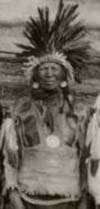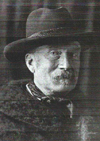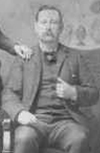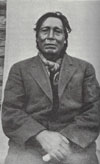Based on John S. Gray’s tables in Custer’s Last Campaign: Mitch Boyer and the Little Bighorn Reconstructed unless noted otherwise. Several people commented on this timeline when it was originally published on LittleBighorn.info; those comments are in italics.
June 25, 1876
PM
Noon: Command passed the Crow’s Nest and crossed the Divide. There is substantial testimony that the time for this event was significantly earlier.
 12:05: Command at Halt 3; General George Custer assigned the battalions. This is 2nd Lieutenant George Wallace‘s Halt 2, about 1/2 mile west of the divide. Captain Thomas McDougall (left) [in Reno Court of Inquiry: Proceedings of a Court of Inquiry in the Case of Major Marcus A. Reno
12:05: Command at Halt 3; General George Custer assigned the battalions. This is 2nd Lieutenant George Wallace‘s Halt 2, about 1/2 mile west of the divide. Captain Thomas McDougall (left) [in Reno Court of Inquiry: Proceedings of a Court of Inquiry in the Case of Major Marcus A. Reno (RCOI)] stated, “On June 25th, about 11 o’clock a.m., I reported to General Custer for orders. He told me to take charge of the pack train and act as rear guard.” If Wallace’s watch (itinerary) was set to Headquarters St. Paul time — and 1st Lieutenant Edward Settles Godfrey said definitely that “Our watches were not changed (RCOI)” — Wallace’s 12:05 is approximately = 10:45 local time, within 15 minutes of McDougall’s recalled 11:00. Cf. Friedman, recalled time is accurate within one hour excluding the possibility of chance in Memory & Cognition 15.6 (1987): 518-20.
(RCOI)] stated, “On June 25th, about 11 o’clock a.m., I reported to General Custer for orders. He told me to take charge of the pack train and act as rear guard.” If Wallace’s watch (itinerary) was set to Headquarters St. Paul time — and 1st Lieutenant Edward Settles Godfrey said definitely that “Our watches were not changed (RCOI)” — Wallace’s 12:05 is approximately = 10:45 local time, within 15 minutes of McDougall’s recalled 11:00. Cf. Friedman, recalled time is accurate within one hour excluding the possibility of chance in Memory & Cognition 15.6 (1987): 518-20.
12:12: Custer-Reno battalions left the divide halt to descend to Reno Creek. Captain Frederick Benteen‘s battalion left the divide halt on an off-trail scout to the left. It is unlikely that all three columns actually set off at precisely the same time but the impact is only a few minutes.
12:32: The pack train left the divide halt on Custer’s trail.
 1:20: Benteen’s battalion arrived at upper No-Name Creek and turned down it. On a high ridge ahead, 1st Lieutenant Francis Gibson (left) found the Little Bighorn valley empty. Many years later Lt. Gibson expressed doubt that he had actually viewed the correct valley (see interview with Camp).
1:20: Benteen’s battalion arrived at upper No-Name Creek and turned down it. On a high ridge ahead, 1st Lieutenant Francis Gibson (left) found the Little Bighorn valley empty. Many years later Lt. Gibson expressed doubt that he had actually viewed the correct valley (see interview with Camp).
2:00: Custer-Reno battalions passed No-Name Creek. Reno was called to the right bank. Sergeant Daniel Kanipe and 1st Sergeant John Ryan, as well as Reno, say Reno was called to the right bank near the Lone Tepee. This subtracts a mile from Gray’s itinerary.
2:15: Custer-Reno battalions passed the lone tepee. Custer’s battalion left down the right bank of Reno Creek. The scouts reported Sioux in the Little Bighorn Valley. Custer ordered Reno to lead out at a trot.
2:17: Boston Custer trots ahead of the pack train to overtake Custer.
2:32: Benteen’s battalion arrived at Reno Creek, 1/4 mile above the mouth of No-Name Creek. They saw the pack train 3/4 mile above. Boston Custer joins them. Benteen (The Custer Myth , p. 180) recalled being at the morass at 1:00 p.m., Godfrey thought 2:00. Assuming Hutchins/Knipe are right about the location of the morass, it is near the mouth of the South Fork.
, p. 180) recalled being at the morass at 1:00 p.m., Godfrey thought 2:00. Assuming Hutchins/Knipe are right about the location of the morass, it is near the mouth of the South Fork.
2:37: Benteen’s battalion reached the morass to water the horses. Boston Custer trotted on.
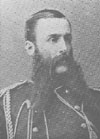 2:43: Custer’s battalion trotted to the flat right behind Reno. The scouts reported the Sioux were alarming the village. Reno was ordered to charge taking Adjutant William W. Cooke (left). Custer sent two scouts to the bluff who joined Reno.
2:43: Custer’s battalion trotted to the flat right behind Reno. The scouts reported the Sioux were alarming the village. Reno was ordered to charge taking Adjutant William W. Cooke (left). Custer sent two scouts to the bluff who joined Reno.
2:45: Boston Custer passed the lone tepee.
2:47: At the North Fork, Reno’s battalion crossed to the left bank of Reno Creek.
2:51: Custer’s battalion made a fast walk to the North Fork and halted to water.
2:53: Reno’s battalion crossed to the left bank of the Little Bighorn River at Ford A where it halted to water the horses and reform. The troops and the scouts saw the Sioux attacking.
2:55: Cooke left to report to Custer.
2:57: Benteen’s battalion departed the morass as the packtrain arrived. The packtrain halted to water and close up.
3:01: Cooke reported the Sioux were attacking Reno. Custer’s battalion started down the right bank of the Little Bighorn River, leaving the north fork of Reno Creek.
3:03: Reno’s battalion left Ford A and started its charge down the left bank of the Little Bighorn River. If Reno crossed Reno Creek near the Lone tepee at 2:00 according to Wallace’s watch, he was about 3-3.5 miles from Ford A. The column proceeded at a trot or “slow gallop” for 15 minutes, again according to Wallace. This would cover about 2 miles at 7.5-8 mph. Wallace said Reno was ordered to attack about 2:15. He took the gallop and covered the remaining mile to the river in about 5 minutes (gallop 9-11 mph in Upton, 1 mile in 6 minutes according to Cooke), and crossed at Ford A at 2:20 in Wallace’s recollection. Using Anders’/Graham’s 1 hour 20 minute difference between local time and official Headquarters time, then Reno crossed Ford A near 1:00, consistent with recollections of Interpreter Frederick Girard, Acting Assistant Surgeon Henry Porter, Kanipe, and Taylor. Gray added 43 minutes and at least two miles between Reno’s crossing of the creek and fording the Little Bighorn.
3:05: Reno’s battalion saw Custer or the scouts on the right bank bluff.
 3:10: Pony captors leave the Reno charge to capture Sioux herd. 2nd Lieutenant Luther Hare (left) (Custer in ’76
3:10: Pony captors leave the Reno charge to capture Sioux herd. 2nd Lieutenant Luther Hare (left) (Custer in ’76 , p. 65) said he and the Rees rode down the valley while Reno was watering the horses (i.e., crossing river?) and the Rees took off from him about a mile down river. Private William Jackson (William Jackson, William Jackson, Indian Scout: His True Story Told by His Friend,
, p. 65) said he and the Rees rode down the valley while Reno was watering the horses (i.e., crossing river?) and the Rees took off from him about a mile down river. Private William Jackson (William Jackson, William Jackson, Indian Scout: His True Story Told by His Friend, ,
, p.135) said scouts rode out ahead of Reno and turned straight down valley.
p.135) said scouts rode out ahead of Reno and turned straight down valley.
3:12: Benteen’s battalion walked past the lone tepee.
3:13: Reno’s battalion saw Custer’s battalion at Reno Hill. Custer’s battalion saw Reno charge the village.
3:15: Sgt. Daniel Kanipe left for Capt. Frederick Benteen and the pack train.
3:17: The pack train left the morass.
3:18: Reno’s battalion halted and formed a skirmish line. They saw Custer’s battalion on the bluffs, disappearing. Custer’s battalion passed Sharpshooter Ridge and entered Cedar Coulee. Reno’s attack/formation of skirmish line occurred about midday, probably 1:00 pm.
3:20: Little Sioux (Ree), Strikes Two (Ree), Red Star (Ree), Boy Chief (Ree), One Feather (Ree), Bull Stands in Water (Ree), and Whole Buffalo (Sioux) diverged from Reno’s charge and drove captured Sioux ponies up the bluff. They were joined there by seven stragglers who lagged behind on Custer’s trail and never crossed the Little Bighorn: Soldier (Ree), Stabbed (Ree), Bull (Ree), White Eagle (Ree), Red Wolf (Ree), Strikes the Lodge (Ree), and Charging Bull (Ree). If they left the column at 3:10 (above), how could they diverge from Reno’s charge at 3:20?
3:23: Custer’s battalion arrived at the bend of Cedar Coulee and halted.
 3:24: Custer, his officers, Guide Mitch Bouyer (left) and Curley left the bend on a side trip to Weir Peak.
3:24: Custer, his officers, Guide Mitch Bouyer (left) and Curley left the bend on a side trip to Weir Peak.
3:26: Three Crows left the halted command at the bend of Cedar Coulee (off-trail). Goes Ahead (The Teepee Book, 2.6, June 1916, p.604) says scouts were told to make their escape at the trenches of the Reno-Benteen site.
3:28: Custer’s party arrived at Weir Peak and saw the village and Reno skirmishing.
3:28.5: The three Crows halted on the bluff above Weir Peak.
 3:30: 1st Lieutenant Charles DeRudio (left) saw Custer’s party at Weir Point. Custer’s party saw the concealed route to Ford B and the village. Not possible to identify individual and/or clothing on Weir from valley position. Who DeRedio saw remains open to question.
3:30: 1st Lieutenant Charles DeRudio (left) saw Custer’s party at Weir Point. Custer’s party saw the concealed route to Ford B and the village. Not possible to identify individual and/or clothing on Weir from valley position. Who DeRedio saw remains open to question.
3:31: Custer and officers left Weir Peak to return to the command. The Arikara were fired on by the last of Custer’s column as it was disappearing over Weir (on the eastern edge), crossed Kanipe’s route, encountered stragglers left behind Custer’s column. Custer in ’76, 180-1; Arikara Narrative of Custer’s Campaign and the Battle of the Little Bighorn , 115-6.
, 115-6.
3:32: The pack train passed the lone tepee.
3:32.5: Boston Custer passed Reno Hill. The Reno fight would have been visible for the next five minutes.
3:33: Reno withdrew the battalion into the timber. The three Crows saw Reno’s skirmish, fired at the Sioux, and left.
 3:34: Custer returned to the halt at the bend from Weir Peak. Trumpeter John Martin (left) left Custer’s battalion at the bend of Cedar Coulee for Benteen. Custer started down Cedar Coulee.
3:34: Custer returned to the halt at the bend from Weir Peak. Trumpeter John Martin (left) left Custer’s battalion at the bend of Cedar Coulee for Benteen. Custer started down Cedar Coulee.
3:36: Pony captors overtook and passed Sergeant Kanipe.
3:38: John Martin met Boston Custer at the head of Cedar Coulee.
3:39: The three Crows halted, had a drink in the Little Bighorn River, and captured five ponies.
3:40: John Martin saw Reno’s battalion fighting in the timber.
3:40:5: Benteen’s battalion met the Rees driving the Sioux ponies.
3:42: Sergeant Daniel Kanipe met Benteen’s battalion with a verbal message from Custer.
3:45: Little Sioux (Ree), Strikes Two (Ree), Red Star (Ree), Boy Chief (Ree), One Feather (Ree), Bull Stands in Water (Ree), Whole Buffalo (Sioux), Soldier (Ree), Stabbed (Ree), Bull (Ree), White Eagle (Ree), Red Wolf (Ree), Strikes the Lodge (Ree), and Charging Bull (Ree) drove the herd of Sioux ponies back to the packtrain and halted. Pretty Face (Ree) was with the packs until this time.
3:46.5: Custer’s battalion halted at the mouth of Cedar Coulee.
3:48: The pack train met Kanipe who had Custer’s message.
3:49: Boston Custer overtakes Custer’s battalion at the mouth of Cedar Coulee with news. The three Crows continued upriver.
 3:52: Black Fox (Ree) (left) was at the bluffs and joined the three Crows who were given a Sioux pony.
3:52: Black Fox (Ree) (left) was at the bluffs and joined the three Crows who were given a Sioux pony.
3:53: Reno ‘s battalion began its retreat upstream. Girard (RCOI) puts this about 2:00. His watch, giving timing of sunrise near 4:00 a.m. local time and full dark at 9:00 p.m., reflects local time fairly closely. Additionally, Girard’s watch times closely match the captured Rosebud watch timing the entire fight from skirmish line to the surround on Reno Hill from 1-4. It is, per Hardorff, extremely unlikely that Crook, who was headquartered in Omaha, would have set his command watches to San Francisco time. Headquarters is where the general is, and the general had been in the field (Douglas, Wyoming, approximates headquarters) for more than a year. Headquarters time is what the general says it is–why set watches an hour and a half off daybreak, noon?
3:55: Rees switched to fresh Sioux ponies and started back to Reno. Custer’s battalion saw signals by Mitch Boyer and Curley on Weir Ridge.
3:56.5: Custer’s battalion started down Medicine Tail Coulee.
3:58: Benteen’s battalion met Trumpeter John Martin at the flat where they heard firing. The three Crows passed Reno Hill and saw Reno’s retreat.
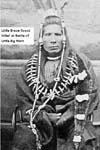 4:00: Reno’s battalion retreats across the Little Bighorn River. Bobtail Bull (Ree) and Little Brave (Ree) (left) had been killed on the east bank by this time.
4:00: Reno’s battalion retreats across the Little Bighorn River. Bobtail Bull (Ree) and Little Brave (Ree) (left) had been killed on the east bank by this time.
4:02: Benteen’s battalion took Custer’s trail at the North Fork.
4:04: Custer’s battalion halted in Medicine Tail Coulee where Boyer and Curley joined them.
4:04:5: The packtrain was overtaken by the Rees who were returning to Reno Hill.
4:05: Young Hawk’s party was trapped on the east bank bottom by the Sioux and fought. Scout George Herendeen‘s party scrambled back to the timber from the retreat.
4:06: Benteen’s battalion saw Reno’s retreat at the knoll and halted.
4:08: Captain George Yates‘ battalion (Companies F and E, off-trail) left the separation halt down Medicine Tail Coulee. Custer’s battalion (Companies C, I, and L) left the separation halt north out of Medicine Tail Coulee.
4:10: Benteen’s battalion met three Crows and one Ree and left the halt. Reno’s battalion climbed the bluffs obliquely to Reno Hill. Private William Baker (1/2 Ree), Private William Cross (Ree, 1/2 Sioux), Red Bear (Ree horse herder), White Cloud (Sioux rear guard), Ma-tok-sha (Sioux), and Caroo (Sioux) arrived at Reno Hill. Red Bear and White Cloud left to join the pony captors. Herendeen’s party met 12 troopers who had been left in the timber.
4:15: Red Bear and White Cloud met three Crows and Black Fox and halted to await the return of the Crows.
4:16: Custer’s battalion arrived on Luce Ridge and halted on the defensive position.
4:18: Yates’ battalion arrived at Ford B. Light firing over the Little Bighorn began. Custer’s battalion saw and heard the firing.
4:20: Benteen’s battalion reached Reno Hill and joined Reno’s battalion. Three Crows and Black Fox arrived. The three Crows left to go downstream, passing Reno Hill, to find Reno’s two Crows. Custer’s battalion saw the Sioux coming up Medicine Tail Coulee to attack. (MF, I think the Gray time of 4.20 for Benteen on Reno Hill is completely wrong and the time to be used is either 2:30 p.m. as per the Official Army Report or 3:45 p.m., which was Wallace’s headquarters time estimate based on his testimony at RCOI which he miscalculated as being 4:00 p.m. Gray’s understanding of the time of events by this stage is so wrong that it is not really possible to comment further. There is no primary source evidence to support Gray’s 4:20 p.m. for this meeting.)
4:23: Yates’ battalion crossed Deep Coulee and arrived on the cutbank unopposed. Custer’s battalion saw Yates start up the west rim of Deep Coulee.
4:25: Red Bear and White Cloud left for Reno Hill when the Crows failed to return. Custer’s battalion pinned down the Sioux with heaving firing. Young Hawk‘s party and Herendeen’s party heard heavy Custer firing downstream. Reno left in search of 2nd Lieutenant Benjamin Hodgson‘s body.
4:27: The pack train halted at the flat to close up. 1st Lieutenant Edward Mathey sighted smoke. Custer’s battalion left Luce Ridge to meet Yates downstream.
4:30: Black Fox arrived at Reno Hill. Red Bear and White Cloud arrived for the second time. Young Hawk’s party and Herendeen’s party saw the Sioux leave the upper valley. The three Crows arrived at Sharpshooter Hill and heard Custer’s battalion firing.
4:32: Little Sioux, Strikes Two, Red Star, Boy Chief, One Feather, Bull Stands in Water, Whole Buffalo, Soldier, Stabbed, Bull, White Eagle, Red Wolf, Strikes the Lodge, Charging Bull, and Pretty Face returned to Reno Hill with the ponies from the lone tepee and were greeted by Red Bear and White Cloud. Custer’s battalion arrived at Nye-Cartwright Ridge.
4:33: Yates’ battalion ascended the west rim of Deep Coulee. The Sioux attacked its flanks.
4:38: Custer’s battalion fired at the Sioux on their left flank while negotiating a crossing of upper Deep Coulee.
4:40: Three Crows arrived at Reno Hill, reporting to Red Star that two Crows were killed.
4:45: Young Hawk’s party left for Reno Hill. Three Crows left for their home village.
4:46: Yates’ battalion fought on foot to the reunion point. Custer’s battalion joined Yates.
4:47: The packtrain left the flat and saw the troops on Reno Hill.
4:50: Reno returned from his search for Hodgson and talked with 2nd Lieutenant Charles Varnum. Curley left Custer’s battalion for the mouth of the Bighorn.
4:52: Reno dispatches 2nd Lieutenant Luther Hare to speed up the ammunition mules.
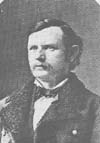 4:55: The sound of Custer’s volleys prompted Captain Thomas B. Weir (left) to ask to move downstream.
4:55: The sound of Custer’s volleys prompted Captain Thomas B. Weir (left) to ask to move downstream.
4:57: The packtrain was at the North Fork and took Custer’s trail.
To be continued. . . .
